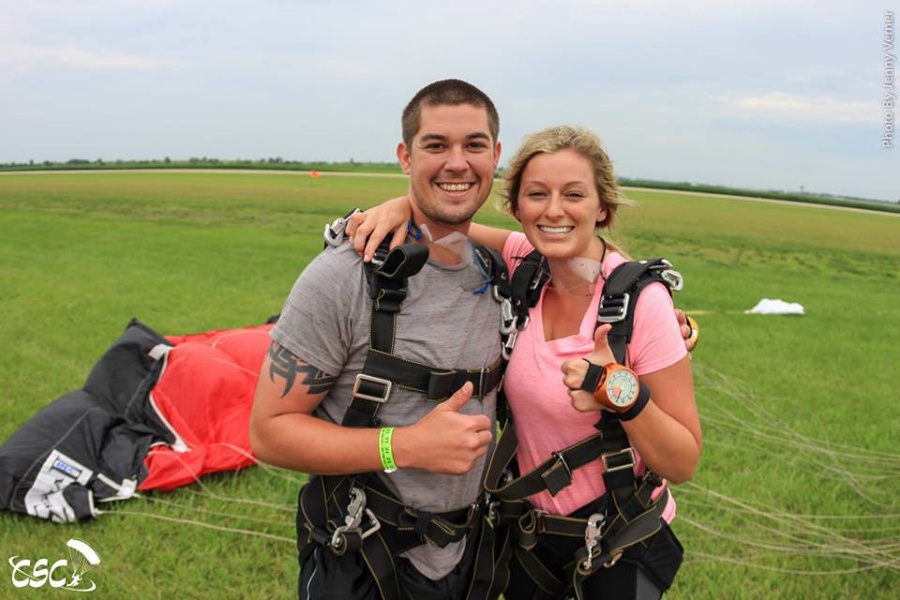If you’re gearing up for your very first skydiving adventure, you probably have a few concerns about how safe it is to freefall. That might be why you stumbled upon this article on skydiving statistics, after Googling things like “how many people die while skydiving” or “how often parachutes fail.”
In this article, we want to show you the real numbers to calm your fears! You’ll probably be surprised to find skydiving is much safer than you imagined.
Here are four interesting skydiving statistics that every first-time tandem skydiver should know:

1. 2.8 Million Skydives Happened in 2020
To first-time jumpers, skydiving can feel like a relatively uncommon sport. After all, some people only skydive once or twice in their entire life (if at all!)— so how could our nation make nearly three million annual jumps? While this statistic may seem large, it’s straight from The United States Parachute Association (USPA).
To boot, that number only reflects skydives made in 2020: the year the COVID-19 pandemic struck America and many skydiving centers shut down for months on end. During the previous “normal” year in 2019, jumps were even higher: at 3.3 million.
This skydiving stat proves that freefalling is a well-loved sport, sure to increase as COVID-19 is better controlled. Our team at Chicagoland Skydiving Center is proud to be one of the few skydiving centers to continue observing strict COVID safety measures as vaccines still roll out. Click here to learn more about our COVID-19 procedures.
2. Only .000045% of Skydives Resulted in Death in 2020
Skydiving can be scary for first-time free fallers. Often, this stems from fear of falling to their death, but skydiving is a surprisingly safe sport compared to other adrenaline rushes.
In 2020, The USPA recorded just 11 skydiving deaths out of 2.8 million who jumped — a fatality rate of only 0.39 per 100,000 jumps. Even in 2019, only 15 lost their lives out of the 3.3 million who jumped.
That means more people died as a result of high-altitude rock climbing or white water rafting, and far more from motor vehicle crashes. Surprisingly, this makes skydiving safer than most people’s morning commutes!
Take a look at the USPA’s statistics on skydiving deaths, called their “fatality index rate.”
Source: https://uspa.org/Discover/FAQs/Safety
With evolving safety technology and procedures, skydiving is getting safer and safer with each passing year. This is especially true for tandem skydiving, which is overseen by a licensed skydiving instructor who is trained, certified, and re-certified to ensure the safest possible jump every time.
3. Skydiving Equipment Must Be Replaced Every 20 Years (CSC’s Is Replaced Every 3 Years)
Often, first-time tandem skydivers are concerned about the safety of their jump harness and parachutes. That’s understandable since without properly fitted and prepared equipment, you risk your safety!
In order to prevent malfunction or failure, all Technical Standard Orders (TSO)-approved skydiving equipment must be frequently inspected and replaced. While some dropzones will use gear for 15-20+ years before retiring the equipment, many often are due for a swap much sooner.
Technology frequently evolves and improves with each year and it’s crucial to stay up to date with it all. That’s why at CSC, you’ll never find a rig that’s been in use for longer than three years.
Some things are even replaced more frequently. Our reserve parachutes, which are inspected and repacked every 180 days by an FAA-certified parachute rigger to ensure they are safe as can be.
Our dedication to safe equipment plays a role in contributing to our perfect student safety record — we’ve never had a death at our dropzone.
4. Parachutes Properly Deploy 99.9% of the Time
Even when skydiving equipment is frequently assessed and replaced, the unexpected can happen. Even seemingly properly packed parachutes can fail, with one in every 1,000 parachutes not always operating at 100% efficiency.
With these stats in mind, skydiving professionals know better to never trust just one chute with their life. That’s why tandem skydivers typically descend with three parachutes.
The first is called the drogue. This chute inflates right after jumping and helps to slow the descent rate and keep you and your instructor in the right orientation: belly-to-earth. The drogue also helps to deploy the large rectangular canopy known as your main parachute, once you hit 5,000 feet above the ground.
In the event that your main chute is acting funky, every tandem skydiving system is also equipped with a reserve parachute that acts as a backup canopy.
With an extra parachute that’s frequently inspected on your back, even if your first line of defense fails, you can rest assured knowing you have a second!
Everything You Need to Know About Your First Skydive
Looking for a few more reasons to try skydiving? We’ve got seven motivations for taking the plunge right here.
If you’re researching some statistics about tandem skydiving, we’re willing to bet you’ll love our Complete Guide to Tandem Skydiving! It answers many common questions around skydiving equipment as well as preparing for your big jump.
Click the button below to download your free guide now.


